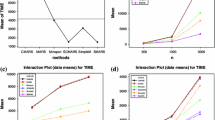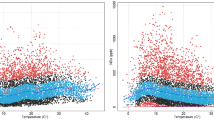Abstract
This article shows how the consumption rate function of a certain customer can be restored from a sequence of discrete purchases. For this, purchases are considered as integrals of the unknown consumption function with some uncertainties. To restore the consumption rate function, it is required to solve the problem of restoring the function from the sequence of integrals. Recovery takes place in the form of a cubic integral smoothing spline. Such integral spline is based on value-second derivative representation. A method for constructing such spline is briefly described. It is shown how to predict future rare events in the economy, based on the restored process parameters, such as the consumption rate.
The choice of the best smoothing parameter \(\alpha \) for cubic integral smoothing spline is considered. This article provides an equation for calculating the cross-validation score \(CV(\alpha )\). Equation for calculating the cross-validation score \(CV(\alpha )\) is adjusted due to the problem of spline identification at the ends of the interval. Oversmoothing problem and optimization of cross-validation are discussed. The problem of application of the L-curve method for cubic integral smoothing spline is considered. L-curve construction stumbles upon the problem of non-monotonicity of residuals and penalty with decreasing smoothing parameter \(\alpha \). Two options for minimizing the sum of residuals and the penalty are considered as analogous to the L-curve method. Extensive simulations have been performed to determine the best way to select the smoothing parameter. It has been shown that due to the peculiarity of the input data, the cross-validation method works only in half of the cases. Recommendations are given for choosing the best smoothing parameter for cubic integral smoothing spline.
















Similar content being viewed by others
Data Availability
Not applicable.
Materials Availability
Not applicable.
Code Availability
Not applicable.
References
Burova, I.G., Rodnikova, O.V.: Application of integrodifferential splines to solving an interpolation problem. Comput. Math. Math. Phys. 54(12), 1966–1978 (2014). https://doi.org/10.7868/S0044466914120102
Kireev, V.I., Biryukova, T.K.: Integro-Differential Information Processing Method and Its Application in Numerical Analysis. IPI RAS, Moscow. (2014) (in Russian)
Fedorova, O.P.: Method of creation of a spline with the integral equal to integral of function of two variables on area of its definition. Sci. Almanac 33, 1–3(15), 31–35 (2016) (in Russian)
De Boor, C.: A Practical Guide to Splines. Springer, Berlin (2001). Revised edn.
Gerritsma, M.: Edge functions for spectral element methods. In: Lecture Notes in Computational Science and Engineering. LNCSE, vol. 76, 199–207 (2011)
Kimeldorf, G., Wahba, G.: Some results on tchebycheffian spline functions. J. Math. Anal. Appl. 33(1), 82–95 (1971). https://doi.org/10.1016/0022-247X(71)90184-3
Green, P.J., Silverman, B.W.: Nonparametric Regression and Generalized Linear Models. A Roughness Penalty Approach. Chapman & Hall, New York (1994)
Korablev, Yu.A.: The function restoration method by integrals for analysis and forecasting of rare events in the economy. Econ. Math. Methods 56(3), 113–124 (2020) (in Russian). https://doi.org/10.31857/S042473880010485-2
Korablev, Yu.A.: Restoration of Function by Integrals with Cubic Integral Smoothing Spline in R. ACM Trans. Math. Softw. 48(2), 22 (2022), pp. 1–17. https://doi.org/10.1145/3519384.
Tikhonov, A.N., Ya, A.V.: Solutions of Ill-Posed Problems. Winston, New York (1977)
Craven, P., Wahba, G.: Smoothing noisy data with spline functions - estimating the correct degree of smoothing by the method of generalized cross-validation. Numer. Math. 31(4), 377–403 (1978). https://doi.org/10.1007/BF01404567
Hansen, P.C.: Analysis of discrete ill-posed problems by means of the L-curve. SIAM Rev. 34(4), 561–580 (1992). https://doi.org/10.1137/1034115
Hansen, P.C.: The L-curve and its use in the numerical treatment of inverse problems. In: Johnston, P. (ed.) Computational Inverse Problems in Electrocardiology. Advances in Computational Bioengineering WIT Press, Southampton (2001)
Morozov, V.A.: Methods for Solving Incorrectly Posed Problems. Springer, New York (1984). https://doi.org/10.1007/978-1-4612-5280-1
Reinsch, C.: Smoothing by spline function. Numer. Math. 10, 177–183 (1967)
Korablev, Yu.A., Golovanova, P.S., Kostritsa, T.A.: Capacity method of rare events analysis in the area of services. Econ. Contemp. Russ. 90(3), 132–142 (2020) (in Russian). https://doi.org/10.33293/1609-1442-2020-3(90)-132-142
Quinn, B.G., Fernandes, J.M.: A fast efficient technique for the estimation of frequency. Biometrika 78(3), 489–497 (1991)
Quinn, B.G., Hannan, E.J.: The Estimation and Tracking of Frequency. Cambridge University Press, Cambridge (2001)
Hansen, P.C.: Rank-Deficient and Discrete Ill-Posed Problems: Numerical Aspects of Linear Inversion. SIAM, Philadelphia (1998)
Golub, G.H., Heath, M., Wahba, G.: Generalized cross-validation as a method for choosing a good ridge parameter. Technometrics 21(2), 215–223 (1979). https://doi.org/10.1080/00401706.1979.10489751
Golub, G.H., Van Loan, C.F.: Matrix Computations, 3rd edn. Johns Hopkins University Press, Baltimore (1996)
Watkins, David, S.: Fundamentals of Matrix Computations. Wiley, New York (1991)
Mueller, J.L., Samuli, S.: Linear and Nonlinear Inverse Problems with Practical Applications. SIAM, Philadelphia (2012). https://doi.org/10.1137/1.9781611972344
Korablev, Yu.A.: Error of the capacity method of rare events analysis, remoteness from the end user. News KBSC RAS 89(3), 48–77 (2019) (in Russian). https://doi.org/10.35330/1991-6639-2019-3-89-48-77
Korablev, Yu.A.: The causes analysis and error estimation of the anomalous pictures in the capacity method for the analysis of rare events. Ekon. Upr. Probl. Res. 8(6), 8–12 (2017) (in Russian)
Winkler, J.R., Mitrouli, M., Koukouvinos, C.: The application of regularisation to variable selection in statistical modelling. J. Comput. Appl. Math. 404, 113884 (2022). https://doi.org/10.1016/j.cam.2021.113884
Swirniak, G., Mroczka, J.: Forward and inverse analysis for particle size distribution measurements of disperse samples: a review. Measurement 187, 110256 (2022). https://doi.org/10.1016/j.measurement.2021.110256
Korablev, Yu.A.: Restoration of a function from different functionals in R for predicting rare events in the economy. Finance: Theory and Practice 26(3) (2022). (in press, in Russian)
Acknowledgement
The reported study was funded by RFBR according to the research project N019-010-00154.
Funding
The authors have no relevant financial or non-financial interests to disclose.
Author information
Authors and Affiliations
Contributions
Not applicable.
Corresponding author
Ethics declarations
Conflict of interest/Competing interests
Not applicable.
Ethics approval
Not applicable.
Consent to participate
Not applicable.
Consent for publication
Not applicable.
Additional information
Publisher’s Note
Springer Nature remains neutral with regard to jurisdictional claims in published maps and institutional affiliations.
Rights and permissions
About this article
Cite this article
Korablev, Y.A. Restoration of the Product Consumption Rate with Integral Cubic Smoothing Spline, Study of the Best Smoothing Parameter Choice. Acta Appl Math 180, 8 (2022). https://doi.org/10.1007/s10440-022-00509-7
Received:
Accepted:
Published:
DOI: https://doi.org/10.1007/s10440-022-00509-7
Keywords
- Consumption rate
- Rare events
- Integral spline
- Smoothing
- Value-second derivative representation
- Smoothing parameter
- Cross-validation
- L-curve
- Tikhonov’s \(\alpha \) regularization parameter




